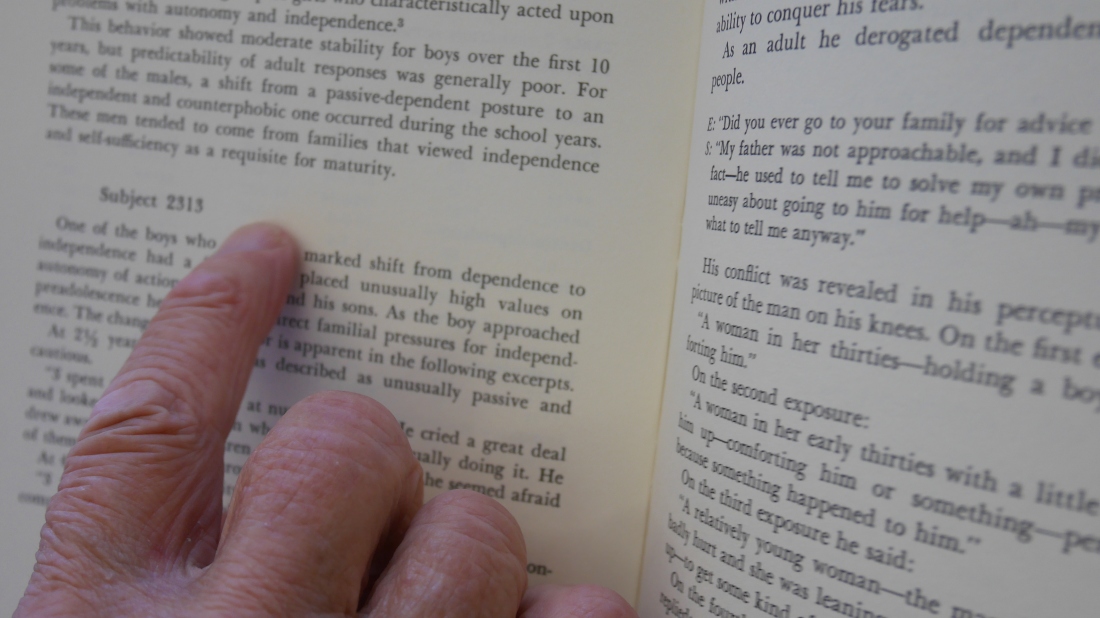
Dr. Jerome Kagan has had an amazing career marked by some very important large scale studies of children. As he describes in the following excerpt from our conversation, the longitudinal study that made his career — the one documented in his book with Harold Moss Birth to Maturity — was a huge gamble and one that he risked his career on completing. This project, and the eventual book that launched Dr. Kagan into the level of renown he gained in the field, won the Hofheimer Prize and it was the first major longitudinal study of typical, american children tracing their personalities and behaviors from birth to adulthood.
Here is Dr. Kagan describing how he came to this project at the Fels Institute at Antioch College, and its impact.
Why did he take this position? Dr. Kagan had a position at The Ohio State University to return to, he just returned from his military experience after being drafted, and here was the newly formed Fels Institute out in Ohio without all the prestige and resources of a major institute?
It was a gamble and one that paid off due to the incredible work of the director of the Fels (Dr. Lester Sontag), the vision of Dr. Kagan to see what they had, and the heartfelt efforts and intensive labor by Drs. Kagan and Moss to complete this longitudinal study. The chutzpahchutzpah of Dr. Kagan comes through so clearly in this audio and I hope you enjoy it.
There is more on Dr. Kagan in my previous post, and many more stories that I look forward to sharing with you in the eventual book.
From these early conversations along my own journey there are some emerging concepts. These innovative Psychologists have tended to demonstrate some great daring to attempt big projects — without necessarily even being aware of what they were stepping into. I think back to my first conversation of this Journey with Dr. Hal Grotevant who set out for some important work on adolescence, but certainly didn’t envision a career of multiple longitudinal studies. But that was what was required and he pressed ahead, enthralled by the power of the work and his own need to serve the field and public with his findings. Or Dr. Dan Schacter who pulled together a biographical work on Richard Semon while a grad student. Eventually he used the ideas from that, his extensive undergraduate research experience, and much more to launch some of the critical research on memory.
We don’t know and we can’t know just where our steps will lead us. And, as demonstrated time and time again, humans are more risk averse than reinforcement oriented. Sure we love our reinforcements, but it hurts more to lose $100 than it feels good to gain the same amount. That sting of negative experiences and aversion to loss colors affective forecasting in Dr. Dan Gilbert‘s research, and biases us to believe the negative experiences are more acute and long-lasting than they actually tend to be.
Despite our tendencies towards risk aversion, despite our assumed frailties of spirit, consistently the influential Psychologists that I have been speaking to took steps fraught with peril. Dr. Jim Sidanius would not be a Swedish citizen with a broad perspective on bigotry if he hadn’t ventured beyond his relative safety — or at least the life he knew — to experience new cultures, languages, and a new life.
Big steps, terrible risks, and incredible success in Psychological discovery.
As I sit far here typing somewhere in New Hampshire, it is difficult not to reflect on my own journey relative to these great, and influential Psychologists. They are iconoclasts, they are daring, and they attempted new ideas time and time again in the face of aversion. Some, like Drs. Sidanius and Kramer, were literally beaten up along their journey. Many were shaped by military experience and being yanked away from their lives, such as Drs. Grotevant and Kagan.
I, and I think many others, want to better understand the great people who created these amazing studies. We want to know the stories of the people and how that might have led to the creation of that great work. For my own part, it felt necessary to be somewhat daring in pursuit of this goal. As I’ve described elsewhere, this is a journey I am taking without an obvious safety net — no home waiting back somewhere, most of our stuff in a storage locker, no guarantee that these great scholars would speak with me, or, even if they do, that the resulting book will be in anyway interesting or successful.
In taking this Journey to Psychology I am nonetheless deeply moved. I am inspired by the will of these amazing Psychologists. I am humbled by the generosity they’ve shared with me about the thoughts and ideas that guided them. And I’m awed by the depth of knowledge, understanding, and sensitivity that they bring to the critical issues in which they’ve found discovery.
Perhaps, the journey itself is the critical part for me. To do that part as fully and richly as possible. To devote myself and, if I do that effectively, then the capacity for discovery has a chance to succeed. No guarantees, lots of potential risk, but, just maybe, it is all worth it. It took Dr. Gilbert a fairly wild journey to even decide that he was going to be a Psychologist. My somewhat wild journey should, at the least, illustrate some of what it might take to gain success.
(*Pictured is the hand of Jerry Kagan as he reads one of the rich accounts describing a child in the files at the Fels Institute).
4 thoughts on “Dr. Jerome Kagan and the Journey to create Birth to Maturity”